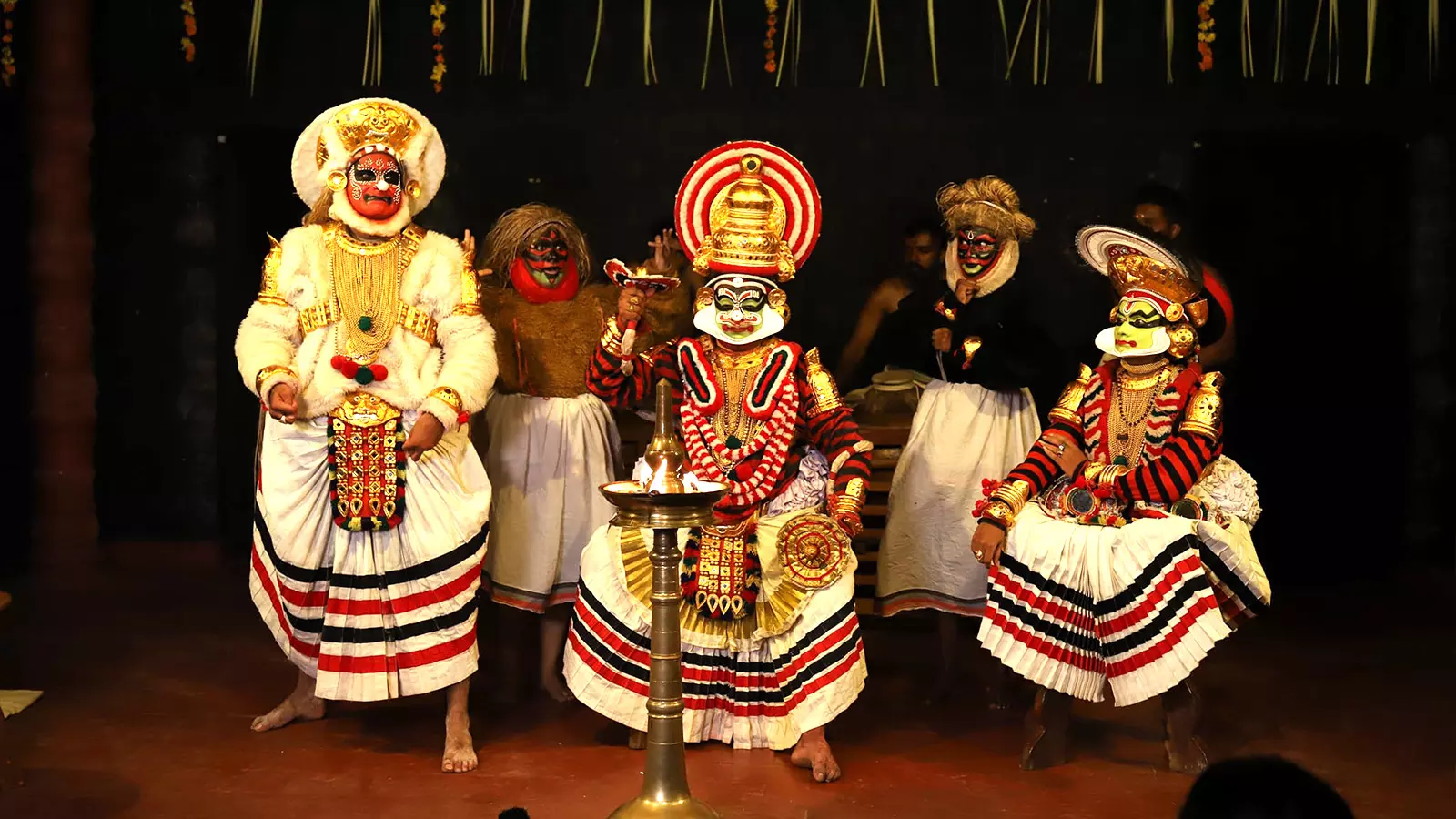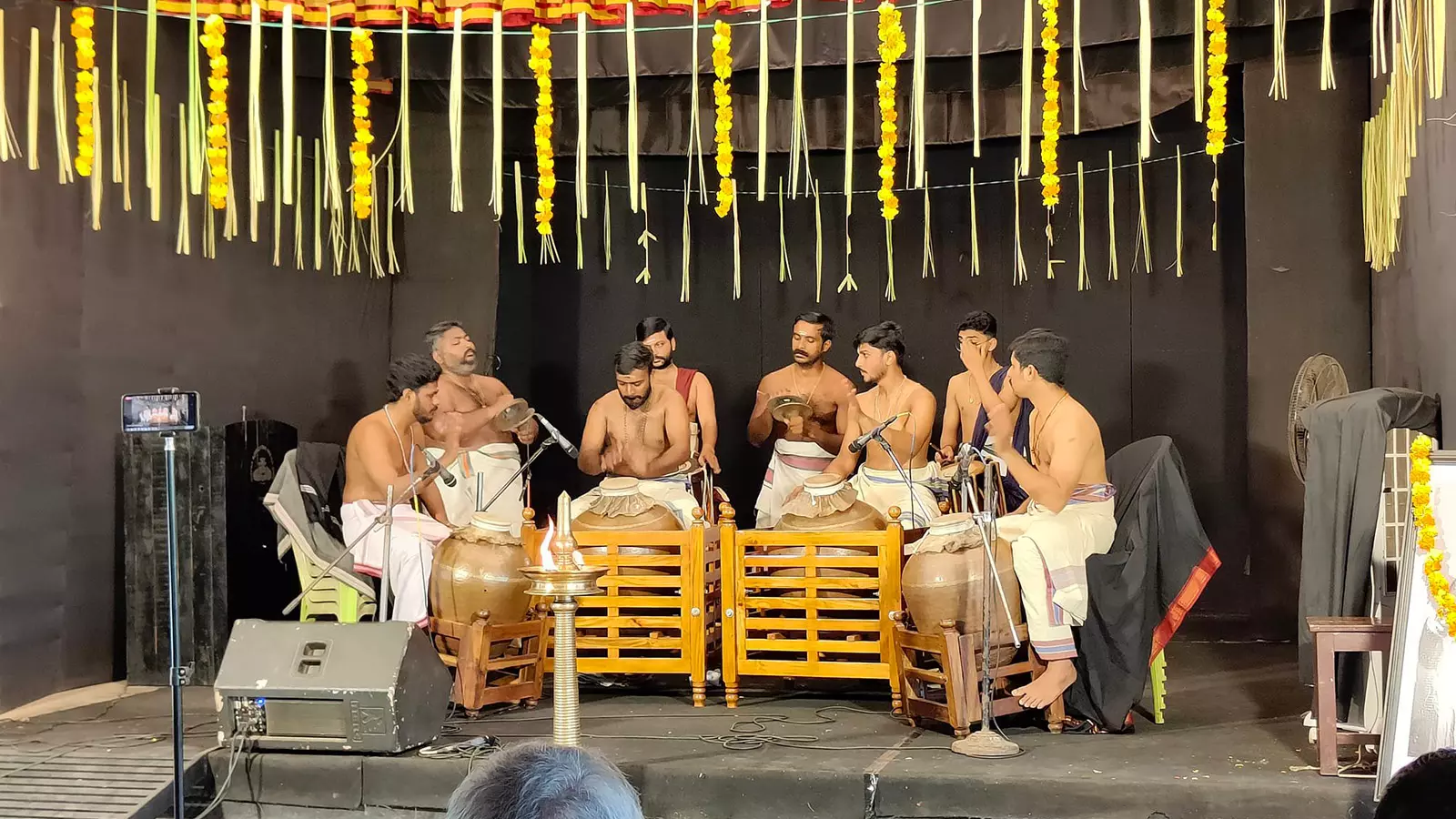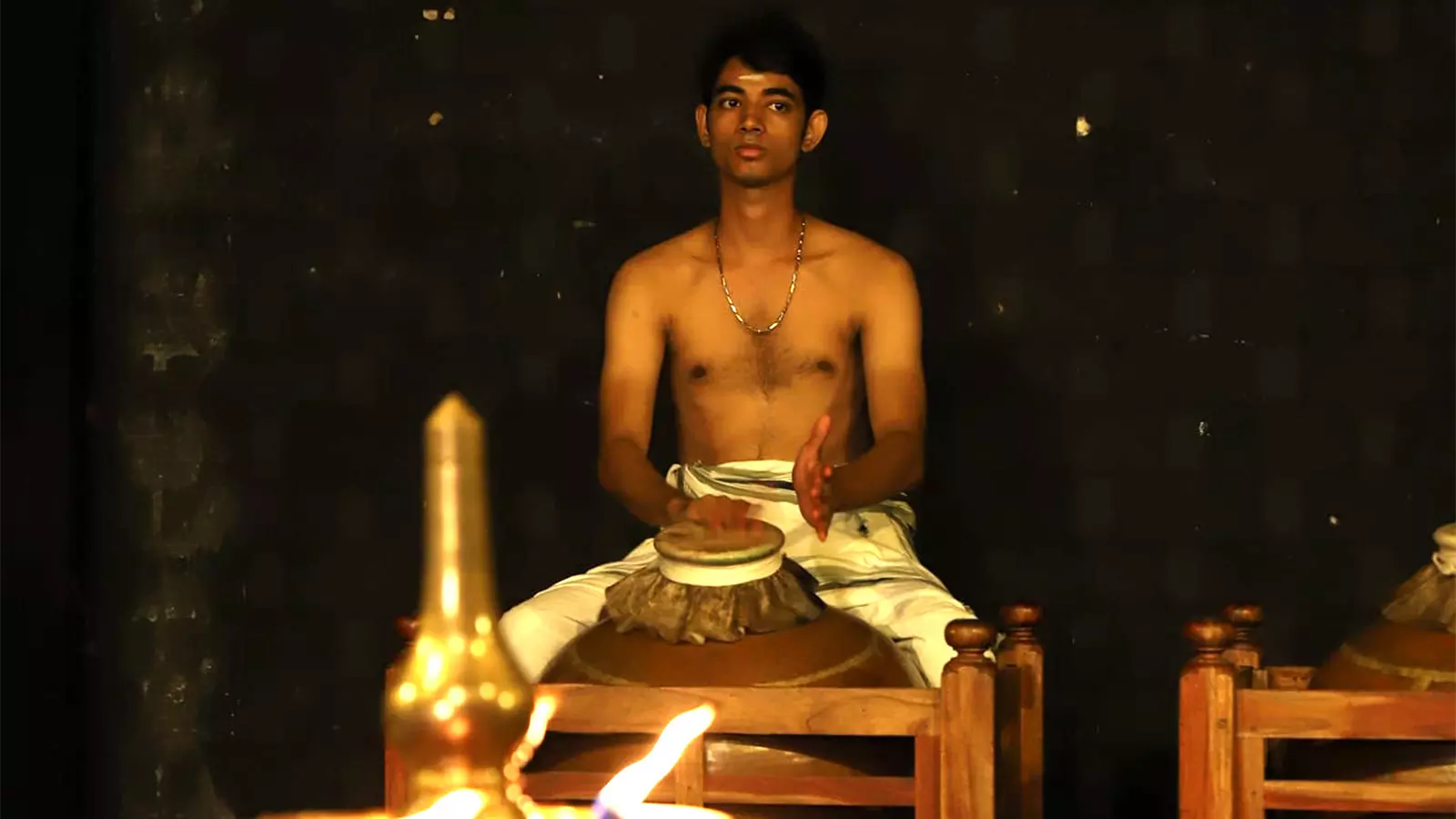
- Home
- India
- World
- Premium
- THE FEDERAL SPECIAL
- Analysis
- States
- Perspective
- Videos
- Sports
- Education
- Entertainment
- Elections
- Features
- Health
- Business
- Series
- In memoriam: Sheikh Mujibur Rahman
- Bishnoi's Men
- NEET TANGLE
- Economy Series
- Earth Day
- Kashmir’s Frozen Turbulence
- India@75
- The legend of Ramjanmabhoomi
- Liberalisation@30
- How to tame a dragon
- Celebrating biodiversity
- Farm Matters
- 50 days of solitude
- Bringing Migrants Home
- Budget 2020
- Jharkhand Votes
- The Federal Investigates
- The Federal Impact
- Vanishing Sand
- Gandhi @ 150
- Andhra Today
- Field report
- Operation Gulmarg
- Pandemic @1 Mn in India
- The Federal Year-End
- The Zero Year
- Science
- Brand studio
- Newsletter
- Elections 2024
- Events
How young Koodiyattam artists preserve the oldest living Sanskrit theatre tradition in Kerala

In 2001, UNESCO recognised Koodiyattam, a 1000-year-old Sanskrit theatre, as an intangible cultural heritage of humanity. The recognition made the Sanskrit theatre tradition of Kerala popular across the world and many flocked to the state to know more about it. While some started learning Koodiyattam, others chose to do research on one of India’s oldest surviving theatrical forms.The...
In 2001, UNESCO recognised Koodiyattam, a 1000-year-old Sanskrit theatre, as an intangible cultural heritage of humanity. The recognition made the Sanskrit theatre tradition of Kerala popular across the world and many flocked to the state to know more about it. While some started learning Koodiyattam, others chose to do research on one of India’s oldest surviving theatrical forms.
The widespread interest that followed after the UNESCO recognition made the ancient performing art form more popular. Books, research articles and features on Koodiyattam followed one after the other. The artists from Kerala found venues outside the state and abroad. However, the recognition didn’t help Koodiyattam recover from a slumber that it underwent after a series of social and cultural shifts in Kerala during the 1950s and 60s. Even though Koodiyattam has a long history of performance, the same doesn’t reflect in the numbers of artists who perform it. Only a hundred artists (including percussionists), perform Koodiyattam and its subsets such as Nangiar Koothu (performed only by women) and Chakyar Koothu today.

Thoranayudham, a story based on Ramayana, was performed at the recently held Koodiyattam fest.
There are social, political and cultural reasons behind the non-popularity of Koodiyattam but some theatre and art lovers still try their level best to preserve the ancient Sanskrit theatre. ‘Cholliyattam’ is a collective of young Koodiyattam artists in Kerala. Launched in 2021 during the Covid-19 pandemic, the collective today plays an important role in providing a common platform for the Koodiyattam artists belonging to various schools in Kerala. The idea is to promote Koodiyattam and preserve the ancient Sanskrit theatre. The collective recently organised its second Koodiyattam festival called Natya-Yauvanam 2024 in September in Irinjalakuda near Thrissur. The festival was one of its kind and it evoked a tremendous response.
“It was during the outbreak of Covid-19 that we launched an informal group of Koodiyattam artists on Whatsapp. There were barely 20 members and they included artists who perform Koodiyattam, Chakyar Koothu, Nangiar Koothu and percussionists. We would post Koodiyattam events taking place in various places in the group. The group was not active in the beginning until we organised our first Koodiyattam festival in Karalmanna in Palakkad in 2023. It was a turning point and many young Koodiyattam artists and percussionists performed in the festival,” said Ammannur Madhav Chakyar, president of Cholliyattam collective. “The idea of conducting a Koodiyattam festival was to create a platform for the young artists belonging to various schools. It evoked great response and we started discussing various aspects about the performing art form through the group since then,” he added.
Koodiyattam was performed before a special audience at big temples as a theatre ritual in Kerala till 1950. Once confined to the Koothambalam (traditional temple theatre hall) and performed only by the members of the Chakyar communities, the Sanskrit theatre is today performed outside the temples and also by members of other communities. For a variety of reasons, Koodiyattam has declined over recent centuries, according to Heike Moser, a German Koodiyattam artist who heads the department of Indology at Institute of Asian and Oriental Studies, Tuebingen.
“In the 20th Century, once-rich temples lost their holdings in the wake of land reforms. This led to the drastic curtailing of performances. Additionally, there was a decline in Sanskrit scholarship, and there were few Sanskrit scholars who could follow a theatre intended for the educated elite who had properly cultivated an appreciation for its subtly mediated messages,” writes Moser in an article published in a book titled Emotions in Rituals and Performances edited by Axel Michaels and Christoph Wulf.
Koodiyattam dramas are mainly based on stories narrated in the epics such as Ramayana and Mahabharata. Renowned indologist David D Shulman said from the vast literature of classical and mediaeval Sanskrit drama, only one tradition of live performance has survived—the intricate, elaborate, and refined art form known as Koodiyattam, still performed by a handful of families in central and southern Kerala on the south-west coast of India. However, the art form underwent many changes.
“Performances of Koodiyattam now tend to be truncated, reduced to two or three hours in a single night, as opposed to the full-length performances that would normally range from twelve hours to over 150 hours spread out over many days or nights. Since the older economic basis of the tradition in temple endowments has been lost, this art now competes in the open market with all other, modern forms, including contemporary cinema.” writes David Shulman in one of his research papers on Koodiyattam. Mizhavu, Edakka, Kurumkuzhal, Kuzhitalam and Sankhu are the main percussion instruments used in Koodiyattam. In 1949, Painkulam Rama Chakyar, an expert in Chakyar Koothu (a satirical subset of Koodiyattam), who first brought the art form to laymen, breaking the so-called practice of it being staged only in the Koothambalam of temples. He performed Koodiyattam at many venues outside the temples. It was a bold step and many followed suit.

Artists perform Mizhavu as part of the festival.
Koodiyattam owes much to Bharata’s Natya Shatra, the ancient Sanskrit treatise on performing arts. However, different schools follow different styles today. Nepathya (Aluva), Ammannur Chanchu Chakyar Smaraka Gurukulam (Irinjalakuda), Margi (Thiruvananthapuram), Kerala Kalamandalam (Thrissur) and Painkulam Rama Chakyar Smaraka Kalapeedam (Thrissur) are some of the prestigious institutes where Koodiyattam is taught. The idea of the youth collective, according to Ammannur Madhav Chakyar, is to create a common platform for various styles. “Each school has a style of its own. The main idea of the collective is to provide a platform for all styles. It is a way of learning. In the last two festivals, held in 2023 and 24, the artists interacted with each other and they discussed various aspects of the styles in Koodiyattam. We organised the festivals with the advice of our seniors and gurus,” he added.
Ammannur Madhav Chakyar comes from a traditional family of Koodiyattam artists. He is the grand nephew of Koodiyattam maestro Ammannur Madhava Chakyar (1917-2008) and the nephew of Ammannur Kuttan Chakyar. “Today, people don’t have time to understand the art form. There is a strong belief that ‘Koodiyattam is difficult to understand,’. It’s high time we come out of such a wrong system of belief. A child learns to walk after many falls. Koodiyattam gives a wide possibility when it comes to the details of abinaya. If you get the basics right, you will enjoy it more than any other performing art forms,” said Madhav Chakyar, who has been performing Koodiyattam for the last 15 years.
Even though the youth collective has organised two Koodiyattam festivals successfully since its launch in 2021, it will be organising more programmes including seminars and workshops on Koodiyattam in the coming months. “Lack of support and sponsorship, of course, brings in disappointments but we will overcome it all,” said Sreehari Chakyar, a Koodiyattam performer and member of the collective.
A Kathakali programme is organised by outsiders, say committee members of the temples or clubs, but when it comes to Koodiyattam, the artists who perform themselves organise it. We the artists take initiative. Since Kathakali is popular, young artists get roles but in Koodiyattam senior people do all important roles. Getting the chances is difficult. And that’s when the Koodiyattam festivals come in handy. They give space for young artists like me,” said Sreehari.

Percussion instrument Mizhavu being played at the fest.
Kalamandalam Vijay, a mizhavu player, said even though there are many Koodiyattam collectives, Cholliyattam is the first one with the participation of young artists belonging to various Koodiyattam schools. “As a mizhavu player, I don't need to do too many stylistic changes as most players follow the Kalamandalam style. But playing mizhavu for various artists is a great opportunity to reinvent one’s talent and approach,” said Vijay, secretary of Cholliyattam and an alumnus of Kerala Kalamandalam, the premier public institution which provides training in Kathakali, Koodiyattam, Panchavadyam, Thullal, Mridangam, Carnatic music etc.
One of the oldest percussion instruments, Mizhavu plays a significant role when it comes to performing temple arts of Kerala such as Koodiyattam, Koothu and Nangiar Koothu. Mizhavu consists of a large pot-shaped vessel, resembling a Chinese or Grecian urn, made of copper or clay with a narrow mouth covered with stretched hide, says the website of Kerala Kalamandalam. Due to its tapering end, which makes it difficult to place it on the ground, it is usually placed inside a wooden frame called 'mizhavana'. The player strikes the hide with his bare hands to produce rhythmic notes. “The percussion session at the recently held Koodiyattam festival had artists from various parts of Kerala. The two-day festival helped many exchange their thoughts and ideas. We will be adding more members to our collective,” said Vijay.
